As the list of controlled substances grows longer and regulations tighten up, more and more people, especially teenagers and young adults, turn to substances that are legal for a mind-altering high. Social media and the Internet are rife with ways to get high legally. Common household products can be inhaled, certain spices can be snorted, incense may be smoked, and over-the-counter medications and other products can be consumed, all in an attempt to create an altered state of consciousness.
Illicit laboratories are producing synthetic combinations of unregulated chemicals that can mimic illegal drugs, such as cocaine, heroin, ecstasy, hallucinogenic mushrooms, and marijuana. These legal substances are also often mixed with alcohol or other drugs in order to intensify the effects.
Most of these products are never intended to be consumed, or are labeled as such, and therefore escape regulation of the U.S. Food and Drug Administration, or FDA.
This also means that their effects on the human body and brain may not be fully understood. The risks of ingesting these products may be high, causing damage to internal organs and the brain, and even resulting in a life-threatening or fatal overdose.
Treatment Can Be Life Changing. Reach out today.
Whether you are struggling with addiction, mental health or both, our expert team is here to guide you every step of the way. Don’t wait— reach out today to take the first step toward taking control of your life.
Some of the ways people get high legally include:
- Dusting: inhaling aerosol computer cleaning products
- Sniffing:– snorting fumes from household products
- Huffing: soaking rags with household products and inhaling the fumes
- Bagging: filling a bag with fumes from common products and inhaling the chemicals
- Robotripping:– drinking cough or cold medicine
- Mixing cough or cold medicine with soda and candy: called Sizzurp, Skittles, or Purple Drank
- Choking game: manually cutting off the air supply to the brain until one almost passes out
- Drinking products containing ethanol: products like hand sanitizer, vanilla extract, and mouthwash
- Snorting nutmeg
- Beezin’: putting Burt’s Bees chap stick containing peppermint oil on the eyelids
- Smoking or ingesting potpourri or incense: herbal materials laced with synthetic cannabinoids
- Inhaling or injecting bath salts: products sold as “plant food” or “jewelry cleaner” and containing synthetic cathinones
There are over a thousand common household products that are easily accessible, legal, and cheap that may be used to attempt to gain a high. Over 22 million Americans aged 12 and older have intentionally inhaled the volatile chemicals from a common and legal product at least once in their lifetime.[1]
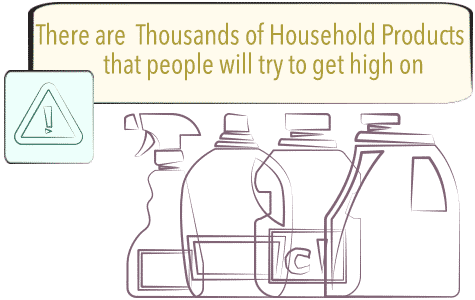
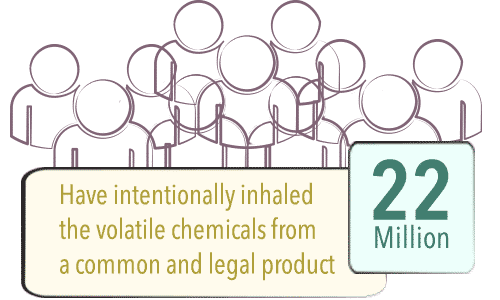
Inhalants
While many different drugs can be inhaled, the class of substances termed “inhalants” is reserved for the vapors of common products primarily inhaled when abused. Inhalants fall into four main categories (volatile solvents, gases, aerosols, and nitrates) and are one of the only classes of drugs more commonly abused by a younger audience.
Almost 60 percent of first-time inhalant abusers try them before the end of 9th grade.[2]
Volatile solvents begin as liquids and become a gas at room temperature while gases are already in gaseous form. Aerosol sprays contain solvents and propellants, and nitrates are mostly used for sexual enhancement. Kids can get psychoactive results from office supplies, cleaners, kitchen products, industrial materials, and medical products, finding them readily accessible in the house, garage, and under the sink. These products are legal for them to buy and possess, and they may not realize the danger they can possess when used to get high.
| Inhalant category | Street names | Types of products | Who typically abuses them |
|---|---|---|---|
| Volatile solvents | gluey, sniff, huff | Paint thinner, nail polish, glue, correction fluid, rubber cement, felt-tip marker fluid, dry cleaning fluid, degreasers, electronic contact cleaners, and gasoline | Younger abusers aged 12-17 |
| Gases | whippets | Whipped cream dispensers, refrigerant gases butane lighters, propane tanks, “laughing gas” or nitrous oxide, other anesthesia gases such as ether, chloroform, and halothane | First-time users aged 16-17 |
| Aerosols | rush, gas | Spray paint, deodorant spray, fabric protectant spray, vegetable oil spray, spray cleaners | Younger abusers aged 12-17 |
| Nitrates | poppers, snappers | cyclohexyl, butyl and amyl nitrates sold as “video head cleaner,” “liquid aroma,” and “room odorizor” | Adults and older adolescents |
Younger children are more likely to experiment with these easily accessible products and inhale them to get high, not understanding the risks doing so may pose. Over 10 percent of 8th graders abused inhalants while only 6.5 percent of 12th graders did so in 2014.[4]
Inhalants typically produce a rush of euphoria, or a rapid high that is similar to alcohol intoxication, and users may slur their speech, have impaired motor control, and appear drunk. The high usually dissipates quickly, which may encourage users to abuse inhalants again and again to perpetuate the effects.
displace the oxygen in the lungs, leading to asphyxiation and an inability to breath. Inhalant users who use the “bagging” method to abuse these substance may suffocate when the plastic bag is over their head. Inhalants may also cause vomiting, and abusers can then choke on the vomit.
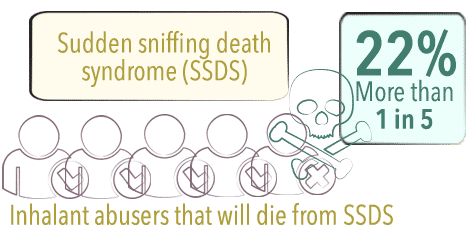
Perhaps one of the scariest potential consequences of inhalant abuse is sudden sniffing death syndrome, which can occur in a healthy person the first time inhalant abuse is attempted.[5]Sudden sniffing death syndrome (SSDS) causes the heart to beat irregularly, leading to heart failure and cardiac arrest.
Approximately 22 percent of inhalant abusers will die from SSDS whether it is their first or 100th time abusing an inhalant.[6]
Short & Long-term Side Effects of Inhalant Abuse
Over 10,000 people sought emergency department (ED) treatment for an adverse reaction related to the abuse of an inhalant in 2011.[7]
Mixing inhalants with other drugs and/or alcohol increases all the risk factors and the potential for a life-threatening and unintentional reaction or overdose.
Inhalants, with the exception of nitrates, typically depress the central nervous system and can cause damage to the kidneys, liver, bone marrow, heart nasal passages, and brain with repeated abuse. Myelin, which is the protective sheathing around nerve fibers, may be damaged by inhalant abuse, which can lead to a loss of coordination. Inhalant abuse cuts off oxygen to the brain, which can have lasting effects and lead to brain damage. Chronic inhalant abusers may experience hearing loss and memory troubles. Inhalant abuse can also suppress appetite and lead to unhealthy weight loss.
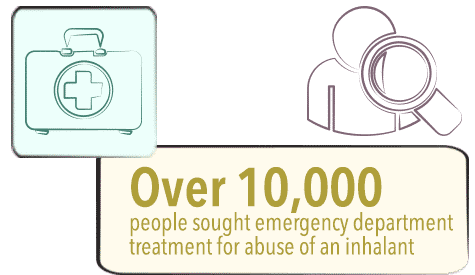
Short-term side effects of inhalant abuse include mood swings, poor decision-making and judgment, nausea and vomiting, hallucinations, and feeling irritable, depressed, and anxious. Nitrates, in particular, can increase the potential for engaging in risky sexual behaviors that may lead to sexually transmitted diseases or unwanted pregnancy.
Abusing substances that have mind-altering effects, such as inhalants, can make chemical changes in the reward and motivation pathways in the brain, creating a spike in the production of “happy cells” or neurotransmitters like dopamine that are responsible for making you feel good naturally. Users can begin to depend on this shortcut to pleasure. The brain may rely on the artificial stimulation and cease to produce dopamine at normal levels on its own, leading to compulsive drug-seeking behaviors as well as physical and psychological dependency. Social withdrawal, mood swings, a drop in productivity, an inability to stop using despite negative health and social consequences, obsession with the substance being abused, and engaging in risky behaviors all may indicate addiction.
Another threat inhalant abuse may pose is the potential increased risk for abusing other illicit drugs. Researchers in 2007 found that 17 percent of teenagers trying new drugs that year reported inhalants as their first drugs of abuse.[8]
‘Not Intended for Human Consumption’
Another class of drugs that flirts with legal status is that of synthetic compounds made to mimic the effects of illicit and illegal drugs. For years, these synthetic substances have been sold at gas stations and head shops, evading regulation from the Food and Drug Administration (FDA) due to false marketing.
They are often labeled as “not intended for human consumption,” even though they are meant to be smoked, ingested, or even sometimes injected for their mind-altering effects.
The Internet is a big source of synthetic drugs, as individuals can buy these products and have the drugs shipped right to their doorsteps. Often,these drugs are plant-based materials and herbs laced with psychoactive chemicals sold as “incense” or “potpourri.”
Many contain synthetic cannabinoids, which may be up to 100 times more potent than tetrahydrocannabinol, or THC, which is the active ingredient in marijuana.[9]
Others are called “bath salts,” or sold as “plant food” or “phone screen cleaner.” They come in a white or brown crystalline powder, which contains synthetic cathinones, or stimulant drugs similar to amphetamines and ecstasy.
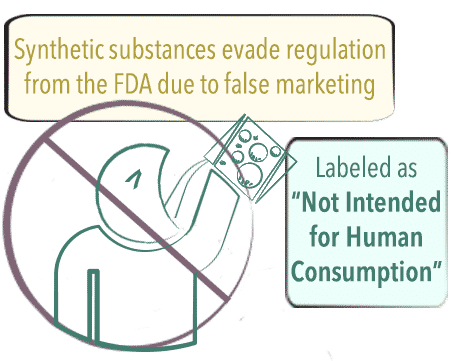
Synthetic cannabinoids activate the cannabinoids receptors in the brain in much the same way as marijuana, leaving users feeling happy, relaxed, and pleasant. Synthetics are, however, more efficient than the real thing and therefore can be more toxic. Even a small amount of “fake weed” can have devastating effects.
In 2011, approximately 28,531 people sought emergency department (ED) treatment after using synthetic cannabinoids.[10]These synthetic cannabinoids, often called “Spice,” exploded onto the market. In 2012, these products were the second most abused drug after marijuana by high school seniors – over 11 percent of 12th graders abused Spice.[11]
These “designer drugs” are manufactured in illicit laboratories and cut with a variety of different things. The bottom line is that you may never know exactly what you are going to get. An overdose on Spice may cause a psychotic break, with hallucinations and effects more similar to an overdose on stimulant drugs than marijuana. An overdose is often indicated by a racing heartbeat, paranoid delusions, sweating, anxiety, aggression, hostility, and irritability, and these symptoms can lead to hypothermia, brain damage, or cardiac arrest.
Another dangerous designer drug that mimics the effects of LSD is N-Bomb, or 251-NBOMe, which in the span of 17 months was responsible for the deaths of at least 19 young adults, aged 15-29, and hundreds of calls to poison control centers.[12]
Poison control calls related to synthetic drugs quadrupled in just one year from 2010-2011, with 60 percent of the cases being young adults under the age of 26, prompting the Drug Enforcement Administration, or DEA, to take notice.[13]The Synthetic Drug Abuse Prevention Act of 2012 permanently lists several synthetic cathinones and cannabinoids as Schedule I controlled substances, rendering their sale and possession illegal in the United States.[14]Many of the known chemicals used in designer drugs have been classified as such to date; however, as soon as the DEA identifies one synthetic compound, another one pops up in its place. As of today, all 50 states have legislation in place to ban synthetic cathinones and cannabinoids in an attempt to stem the tide of these “legal” highs and their potentially tragic results.[15]
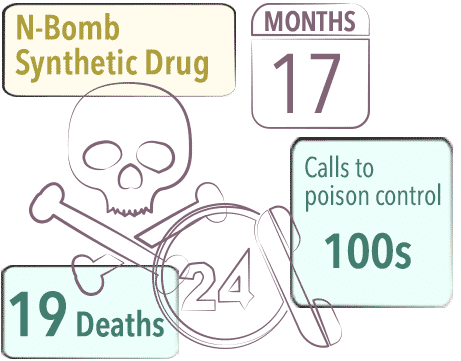
Spice, bath salts, and other designer drugs are sold on the Internet and often labeled with cartoon character packaging, appealing to teens and young adults under street names like:
- Skunk
- Yukon Fire
- K2
- Ivory Wave
- Cloud Nine
The Dark Side of Over-the-counter Medications
Over-the-counter (OTC) and prescription medications are the most commonly abused drugs by Americans aged 14 and older, behind only marijuana and alcohol.[16]Cough and cold medications, particularly those containing codeine or dextromethorphan (DXM), are often diverted and abused in order to get high.
These medications are often mixed with soda and candy for a sweet and almost instantaneous rush of euphoria. Purple Drank and Sizzurp – a mixture of jolly ranchers, Sprite, and cough medicine – can be highly addictive. In 2014, one in ten teens has admitted to drinking cough or cold medicine to get high.[17]In addition to the addictive nature of the high, this drink tastes good, so abusers may continue to drink it throughout the day, not realizing how much they have ingested, thereby increasing the odds for a potentially life-threatening overdose.
DXM products often also contain acetaminophen, an over-the-counter pain reliever, which can damage the liver in high or repetitive doses. DXM and codeine are central nervous system depressants, and an overdose may decrease respiration to dangerously low levels that can be fatal.
DXM is found in numerous over-the-counter cough suppressant medications, including Robitussin DM, Triaminic DM, Dimetapp DM, DayQuil, NyQuil, Tylenol Cold, TheraFlu, and Alka-Seltzer Plus Cold and Cough, to name a few. It can increase heart rate, body temperature, and blood pressure as well as impair motor functions and cause hallucinations in the same manner as PCP or ketamine in high doses. In lower doses, DXM and codeine have similar effects, resulting in mild to moderate intoxication, giddiness, and increased pleasure, due to increased dopamine production and the activation of opioid receptors.
While codeine products are available only by prescription, and therefore, are more tightly controlled and regulated, DXM products can be purchased at your local drugstore or over the Internet. At least five deaths of teenage boys have been specifically linked to DXM toxicity from DXM purchased online.[18]Calls to US poison control centers related toDXM abuseby teenagers doubled from 2000-2003.[19]
Lawmakers reacted to this rise of over-the-counter drug abuse by teenagers, and many states now have laws restricting the sale of DXM products to minors under age 18. On the federal level, the Preventing Abuse of Cough Treatments Act (PACT) has gained traction as well. In 2014, DXM abuse was declining, with 3 percent of teens reporting using DXM products to get high, down from 6 percent in 2006.[20]
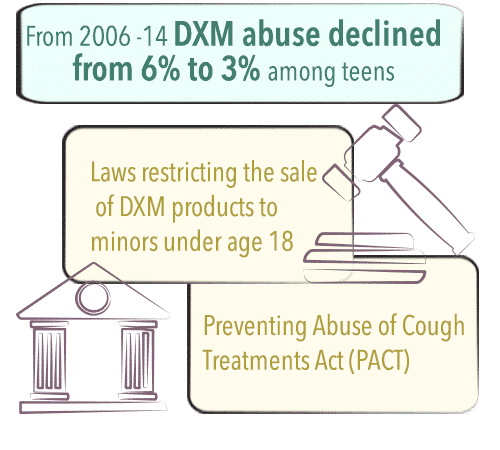
Emerging Trends
When one trend seems to decline, another may fill its place, however. Hand sanitizer is a seemingly innocuous product that most retailers won’t think twice about selling to teenagers. The liquid form can contain 62-65 percent ethyl alcohol, which is akin to a 120-proof alcoholic beverage.[21]Teenagers may be drinking this in order to get drunk with a product they can legally buy and possess.
Drinking hand sanitizer, or other products containing ethanol, such as vanilla extract or mouthwash, can create a “buzz” or intoxication just like alcohol, resulting in slurred speech, loss of motor control, and lowered inhibitions. It brings side effects, such as nausea and vomiting, accidents, and headaches. Drinking a large amount of these products may cause an overdose, which can cause the abuser to lose consciousness, become unresponsive, or even be fatal. In just two years, between 2010 and 2012, California reported 2,600 cases of hand sanitizer intoxication in teenagers.[22]
Teenagers have recently tried snorting nutmeg, a spice found in most household pantries around the country, which can cause hallucinations, diarrhea, vomiting, as well as nerve and heart problems when abused this way. Within 30 minutes, abusers may experience gastric distress, but the visual and auditory hallucinations may take much longer to begin, therefore encouraging abusers to snort more and increasing the potential for an overdose. Hallucinations may mimic LSD and can last for one to two days. In 2010, there were 67 confirmed cases of nutmeg exposure with adverse reactions as it gained an online presence.[23]
Right on the heels of the popularity of nutmeg abuse came the “cinnamon challenge” in which teenagers dared each other to eat a spoonful of dry ground cinnamon in one minute without drinking any water, leading to a surge in poison control center calls from 51 in 2011 to 222 in 2013.[24]This prank is exceedingly dangerous and can lead to choking and aspiration of the powder into the lungs, which may cause a lack of oxygen to the brain, permanent damage to the lungs, or even death.
Adolescents and young children have also been known to crush and snort candy such as Smarties, or exhale the dust like a cigarette, which may cause nasal infections, lung irritations, and even the infestation of maggots in the nasal cavities.[25]
The bottom line is that children, teenagers, and young adults are most likely to experiment with “legal” highs and abuse substances they may deem safer than illicit and illegal drugs. Unfortunately, these substances are generally not tested for use in this way and may have many unintended and adverse consequences, giving teens much more than they bargained for, even when trying something new for the first time.
Designer drugs and new ways to abuse household and common products will continue to pop up online, enticing adolescents to give them a try. It is well documented that the earlier or younger one is when trying a psychoactive drug, the more likely it is that the person will develop a substance abuse disorder later in life. For instance, marijuana abusers who began using the drug before age 14 developed a substance abuse or dependency issue 11.5 percent of the time, while those who waited until after age 18 were classified with substance abuse or dependency only 2.6 percent of the time.[26]
Just because a substance is technically legal does not mean that it is safe to use in a manner that it is not intended to be used. The use or abuse of any mind-altering substance can lead to dependency and addiction.






